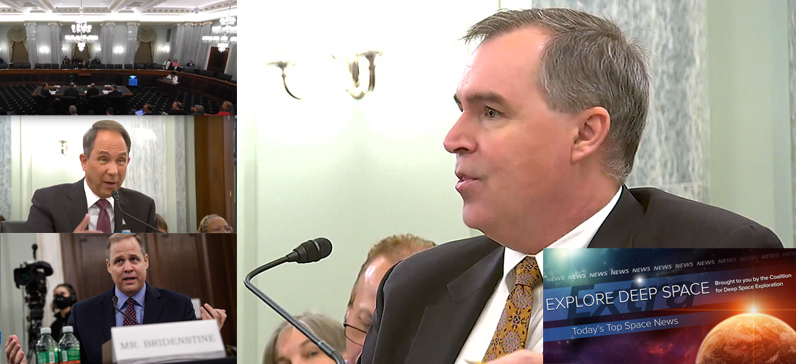Here is a list of news that were published in our Newsletter the week of September 1, 2025:
Human Space Exploration
- Duffy: “I’ll Be Damned” if U.S. doesn’t beat China back to the Moon;
- In rebuke to Trump, Senate hearing warns Artemis changes will let China win Moon race
Coalition for Deep Space Exploration president and CEO Allen Cutler in the News; - U.S. in real danger of losing the Moon race to China, experts tell Senate
Coalition for Deep Space Exploration president and CEO Allen Cutler in the News; - Senators insist Artemis must get America back to the Moon before China
Coalition for Deep Space Exploration president and CEO Allen Cutler in the News; - Watch an asteroid the size of an airliner speed toward Earth live online September 2 (video);
- Has a huge blob of dark matter been found in our galactic neighborhood?
- Making babies beyond Earth? Mouse study suggests we can make it happen;
Space Science
- New isolated early-type dwarf galaxy discovered;
- Huge chunks of cosmic objects may be stuck inside Mars;
- Telescope reveals a growing tail on the comet that’s visiting from another star;
- Total lunar eclipse September 2025;
- Perseverance Mars rover rolls over Soroya Ridge;
- New research shows Mars is far icier than we thought;
- Asteroid Bennu contains stardust that is older than the solar system;
- Metals are critical to life – we should screen exoplanets for them;
- TESS reveals two rocky Earth-sized exoplanets orbiting nearby K-type star;
- Interstellar invader comet 3I/ATLAS could be investigated by these spacecraft as it races past the Sun: ‘This could be literally a once-in-a-lifetime opportunity’;
Other News
- Orbital Paradigm readies first reentry mission;
- Acting NASA Administrator Duffy selects exploration-focused Associate Administrator;
- NASA advances lunar nuclear plan with commercial focus;
- Trump announces Space Command headquarters moving from Colorado to Alabama;
- Rocket Lab inaugurates LC-3 at Wallops;
- Trump’s Labor Union EO designates NASA as primarily an Intelligence/National Security Agency;
- Stormy weather: DoD faces dearth of data from planned NOAA cuts
Coalition Member in the News – Lockheed Martin;
Opinion
- We led NASA’s human exploration program. Here’s what Artemis needs next.
SpaceNews (9/2): In an op-ed, three very experienced U.S. space policy veterans from the Defense as well as the Civil sectors question the adequacy of the nation’s space leadership, citing issues involving the Artemis program’s Space Launch System, Orion crew capsule and in particular the Starship Human Landing System. Authors Doug Loverro, Doug Cooke and Dan Dumbacher call for NASA to immediately stand up a “truly independent review team” to evaluate the program’s status on behalf of the NASA leadership, the president, and Congress. The U.S. is at risk of losing the race to the Moon to China, with national security and economic consequences, they contend.
Major Events This Week:
-
- The U.S. House and Senate are back in session in Washington D.C., with a challenge: completing their budget making activities prior to the start of the 2026 fiscal year on October 1.
- On Wednesday, the Senate Commerce Committee has scheduled a hearing for 10 a.m. EDT on how NASA can be funded and directed to prevent China from delivering its taikonaut human explorers to the Moon ahead of the U.S. and its global partners. Those scheduled to testify include Allen Cutler from the Coalition for Deep Space Exploration (CDSE), Dave Cavossa from the Commercial Space Federation (CSF) and Jim Bridenstine, managing partner of The Artemis Group and former NASA Administrator. The Senate hearing will be live streamed on the committee’s website and YouTube.
- On Thursday, George Washington University’s Space Policy Institute and Law School will host a 10 a.m. to 2 p.m. EDT event, Space Law Across Borders: Comparative Frameworks in the U. S., India, Japan and South Korea.
- On Thursday at 12 p.m. EDT NASA will host a pre-launch news briefing on the planned September 23 launch of NASA’s Interstellar Mapping and Acceleration Probe (IMAP) and the Carruthers Geocorona Observatory. IMAP is to map the outer boundary of the heliosphere, the “bubble” created by the distant expanse of the solar wind and the ultraviolet glow of the Earth’s exosphere, or the outermost region of the planet’s atmosphere. Audio will stream at https://www.nasa.gov/live.
Subscribe to our Daily Newsletter:
Don’t miss the latest developments in space policy, science, and exploration with Deep Space Extra, delivered directly to your inbox from Monday to Friday.
|
|

